UNIT 1: The geography of Rwanda
Key Unit Competence: To use language learnt in the context of
Geography of Rwanda.
Introductory activity: Observation and Interpretation Pictures in
fig 1, 2, and 3.
You will develop these skills
• Use the present perfect tense.
• Use the passive voice.
• Use the present perfect tense with ‘since’.
• Identify and use paragraphs, headings and numbering.
• List and use vocabulary referring to the physical geography, population,farming and trade of Rwanda.
The land of a thousand hills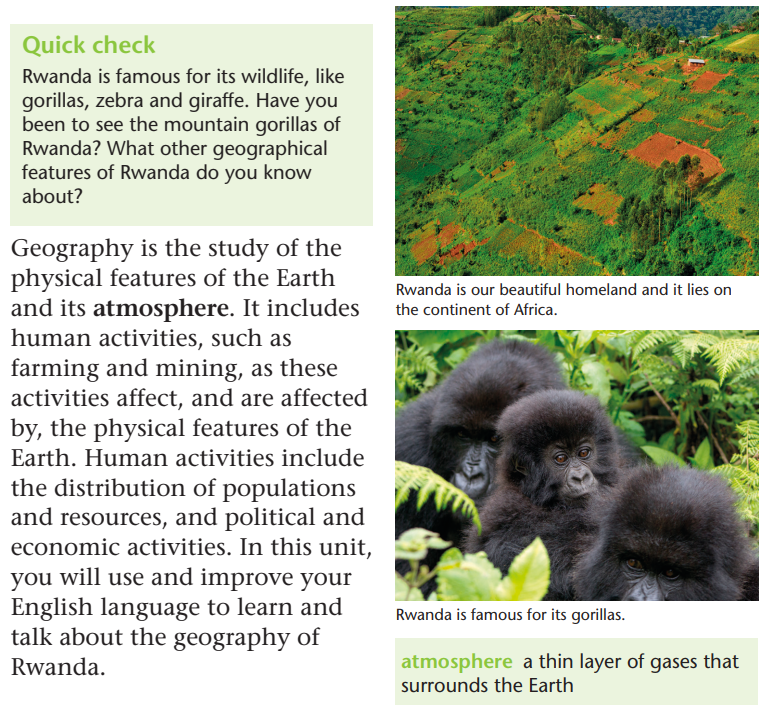
When we write a geographical description of a country, we must
give it a title so that readers know what we are writing about. This
is called the main heading. We then group our information into
paragraphs so that similar information is together. This helps the
writing make sense. Each paragraph starts on a new line. We may
also use a subheading for each new section, to show the readerthat it contains important new facts.
Read about the location of Rwanda
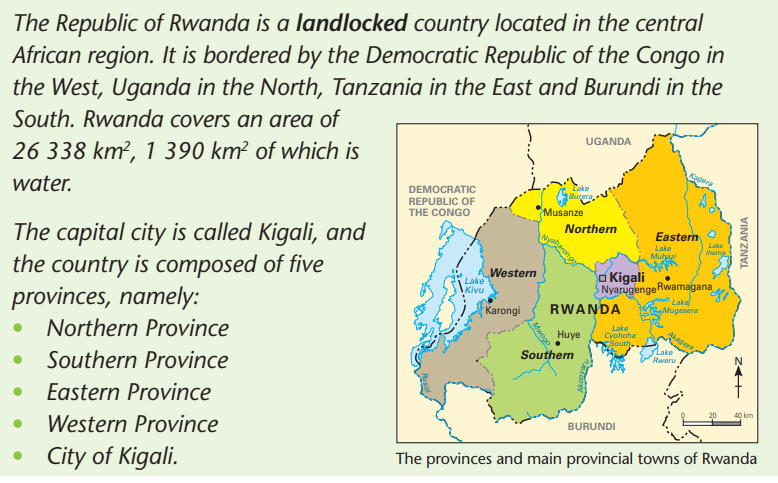
Activity 2: Write about your province
Write a description of your province. Use a main heading and paragraphs. Make
sure that you include the names of the province, the main provincial town, theneighbouring provinces and any mountains, lakes or rivers.
Grammar focus
Use the present perfect tense
The present perfect tense is used to describe something that happened in the
past, but the exact time it happened is not important. We also use this tense
when we want to talk about unfinished actions that started in the past andcontinue to the present. We use the verbs ‘has’ or ‘have’ + past participle.
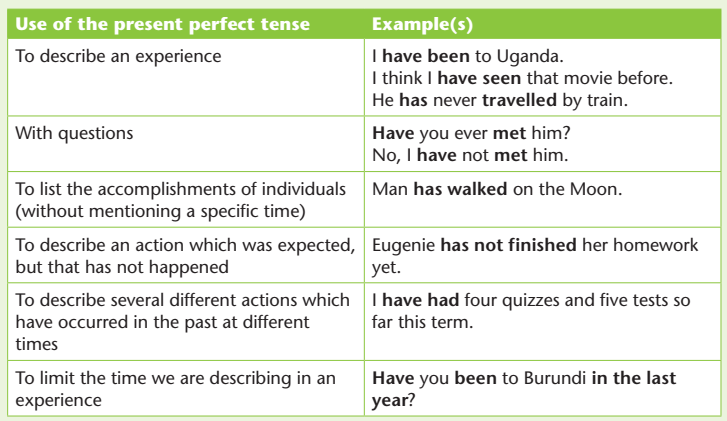
Read about the physical features of Rwanda
The vegetation of Rwanda is varied and includes grassland and savannah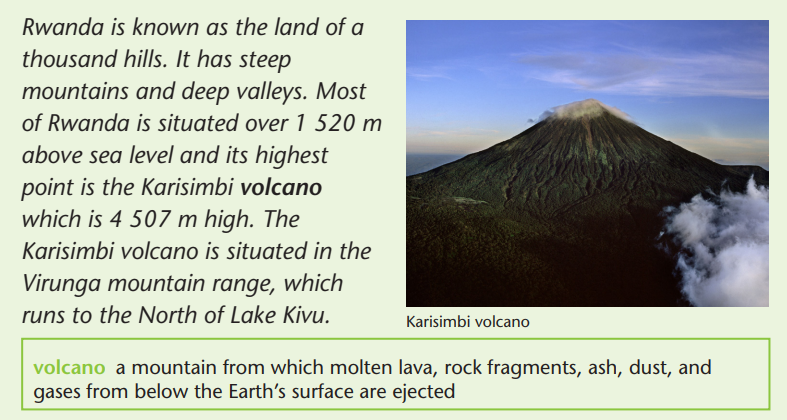
as well as steep, forested mountainsides. Rwanda has an abundance ofwildlife including gorillas, hippos, chimpanzees, storks and cranes.
The main rivers of Rwanda are the Mwogo, Rukarara, Mukungwa, Base,
Ruhondo, Akagera, Nyabarongo and the Akanyaru. Rwanda also contains
many lakes. The main lakes are Lakes Kivu, Cyohoha, Muhazi, Ihema,Rweru, Burera, Ruhondo and Mugesera.
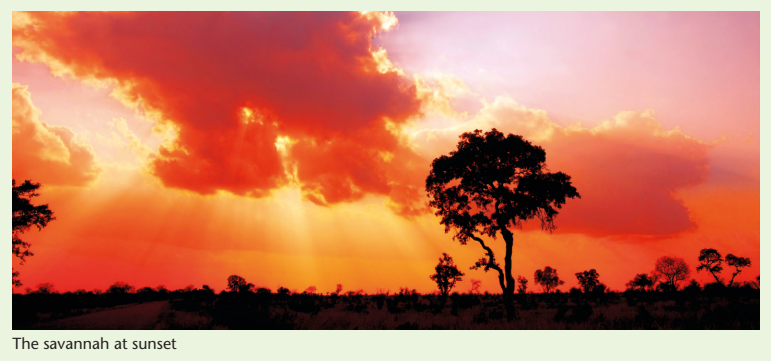
Grammar focus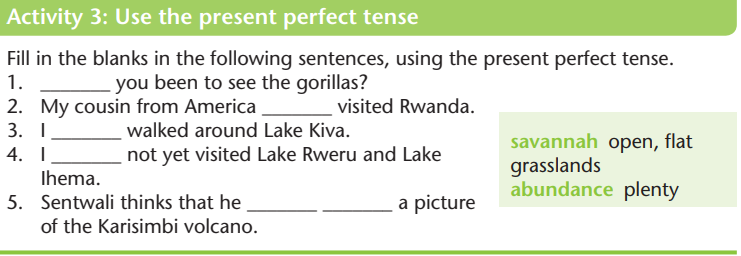
Using the present perfect tense with ‘since’
When we use the present perfect, we can specify a period of time before now by
using the word ‘since’ and a point in time. For example:
• She has lived here since 1980.
• We have taught at this school since 1965.• We have been learning English since we were in primary school.
Read about the population of Rwanda
The population of Rwanda was about 12 million in 2014. In 2010 the
population was 10.5 million. It is believed that the population is now
growing at a rapid rate of about 2.6%. Since 2002 the population has
increased by 2% per annum. However, since 1995 the death rate has
fallen by 3% per annum. It is also worth noting that the fertility rate in
Rwanda is very high, since a Rwandan mother has five children on
average. Rwanda is believed to be the most densely populated country in
Africa. By 2015, males represented 49.1% of the total population and
females represented 50.9%
The population is united by homogeneity of language and culture, whichhas created a group of people with socio-cultural pride and self-esteem.
Read about the climate of Rwanda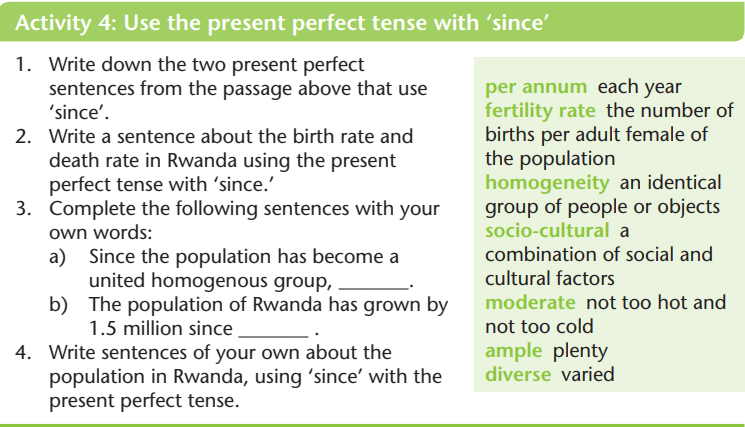
Rwanda is located a few degrees South of the equator. The country is
characterised by moderate temperatures and ample rainfall. The climate
of Rwanda is influenced by the country's diverse physical features. The
most mountainous province is the Northern Province, which ischaracterised by low temperatures and relatively high rainfall.
There are two rainy seasons, namely between March and May, and
between September and December. The average rainfall is 110–190 mm
per month. The hottest months are always June, July and August. There is
a dry spell during January and February. The average temperature isbetween 25° C and 27° C.
Activity 5: Interpret a graph
The following graph shows Kigali’s average temperature and rainfall. Examinethe graph and answer the questions that follow.


Grammar focus
Use the active and passive voice
The passive voice happens when you make the object of an action into the
subject of a sentence. For example, instead of writing: The seagull caught a
fish, we can write: The fish was caught by the seagull.
In the first sentence, ‘the seagull’ is the subject of the sentence and ‘the fish’
is the object of the sentence. In the second sentence, we have put ‘the fish’ first
and made it into the subject of the sentence.
A way to identify the passive voice is to look for a form of the verb 'to be' +
past participle. If we change ‘the chicken crossed the road’ to ‘the road was
crossed by the chicken’, we can identify the passive voice by ‘was crossed’.
This is the verb 'to be' and the past participle of 'cross'. We use the passive voice
when we put insistence to the action performed, and the Active voice is used toinsist the Subject or Doer of the action.
Read about the economy of Rwanda
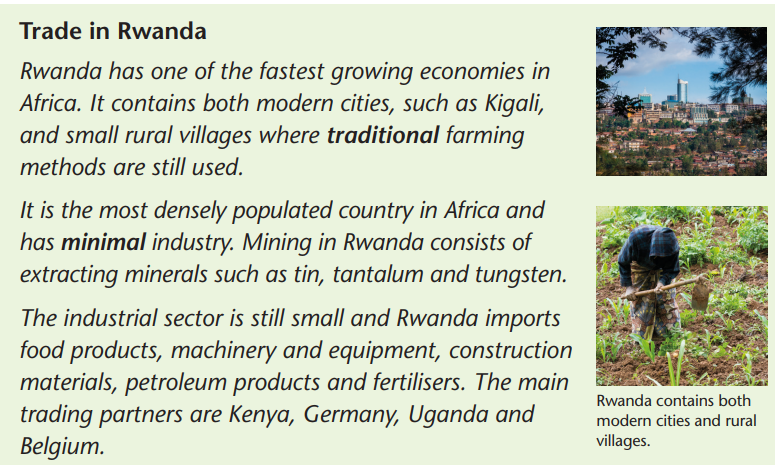

Agriculture in Rwanda
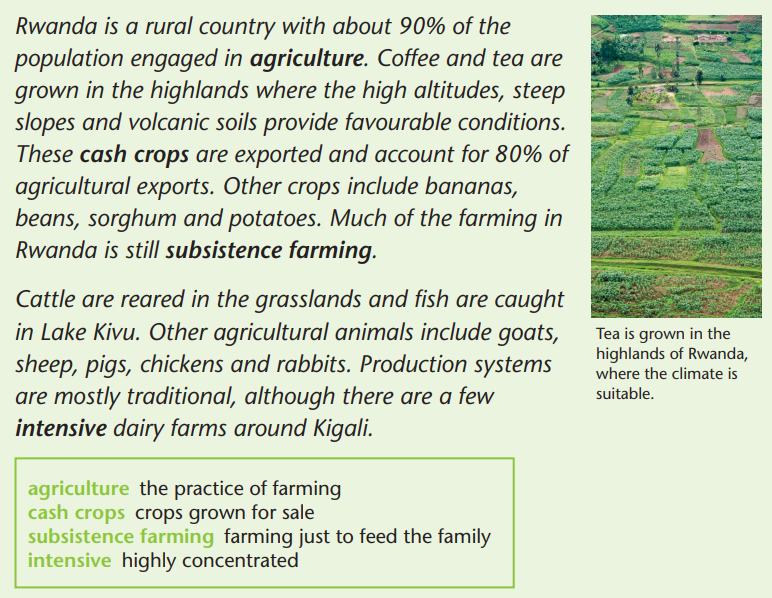
Activity 7: Identify the passive voice
1. Identify the sentences in the text above that use the passive voice.
2. Discuss the importance of agriculture in Rwanda, using the passive voice.
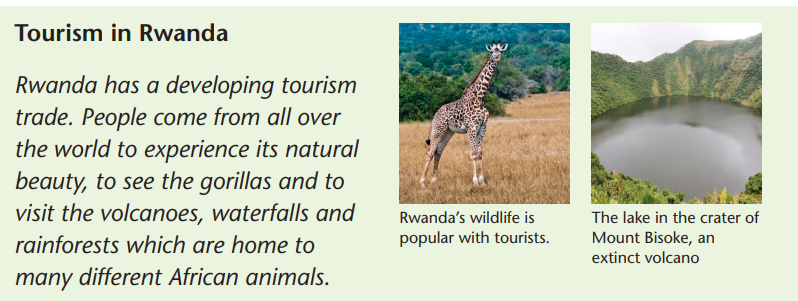
Writing and understanding
Activity 11: Write a leaflet for tourists
Activity 8: Practise using the passive voice
Write four sentences about agriculture or tourism in Rwanda, using the passivevoice in your sentences.
Activity 9: Read and understand
Copy and complete this table with information from the texts on pages 7 and 8.The first question has been done for you.
Vocabulary, pronunciation and spelling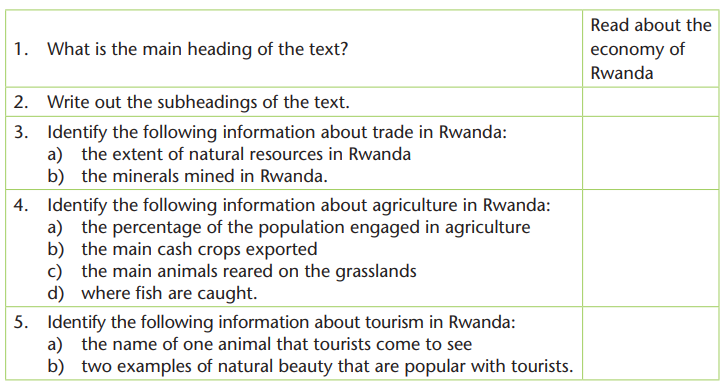
Activity 10: Match words and their meanings
Use your dictionary to look up the words in the left-hand column of the table,
and then match them to the correct description in the right-hand column. Makesure that you can pronounce the words correctly.
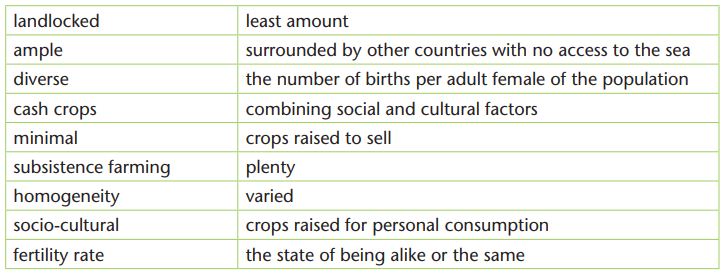
The land of a thousand hills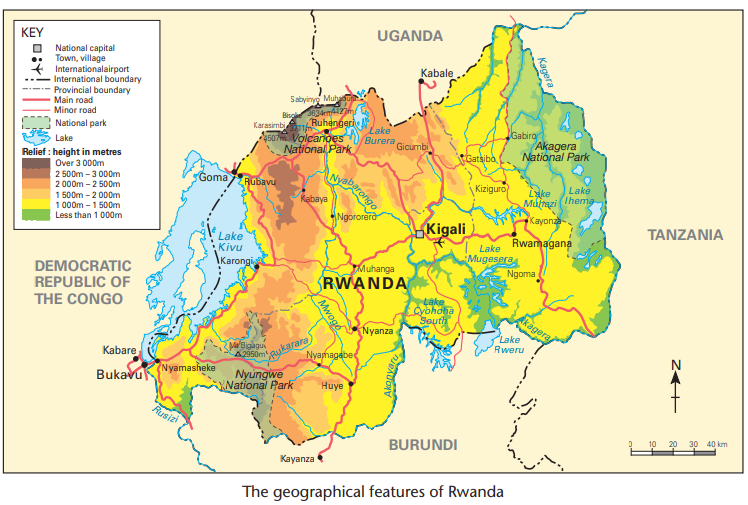
Rwanda is much known for its varied features. The views of its land from
different sides let both the inhabitat and people from other parts of the world
decide to move around the whole country to visit the beauty ot its attractive
environment. The ever green forests make a better home to stay for lions,
buffalos, gorillas, monkeys, antelopes, giraffes,zebra, …;
birds and reptiles of different types. All these characteristics make soil, lakes andrivers, over a great range of hills that make its famous name.
The paragraph above makes a good example of a Standard paragraph.
A Standard Paragraph should have four main parts or sentences respectively
arranged in the following way:
1. TheTopical or Key sentence which announces the idea to follow;
2. The Argument(s) support the key sentence by justifying it.
3. The Example(s) which reinforce both the Key sentence and the Argument(s) by
providing proof through practical facts, that is, through illustrations.4. The conclusion sums up all what was said in the whole paragraph.
Hints:
• Give always a Title to A Standard Paragraph as a Writing Exercise.
• The First and the last Sentences are the most important parts in a standard
paragraph.
• Only the Standard Paragraph has the four parts consecutively arranged in the
way they are. Other forms of paragraphs have either a single part / sentence,
two, three or more sentences.
• All sentences of a Standard paragraph are inter-connected and all of them talkabout the main Heading / title.
Application Activity
The Rwandan Tourism Board has asked you to prepare a leaflet about Rwanda
that can be given to tourists.
• Your leaflet must include information about the geographical features of
interest to tourists, for example national parks, climate, lakes and volcanoes.
You can refer to the map above for the names of important geographical
features.
• Organise you information so that your leaflet is easy to read and understand.
You must make sure that you use headings, paragraphs and numbering.• Make use of the present perfect tense and passive voice.
Ecotourism and environmental awareness
Rwanda is an emerging ecotourism destination. Ecotourism is
tourism that is directed towards encouraging people to visit exotic
natural environments. It is a fairly new but very important
industry. The money earned from ecotourism helps to support
conservation efforts and protect wildlife. It also provides jobs inareas where there are often high levels of unemployment. Another
or ‘beautiful Nyungwe’, the project is helping to turn NNP into an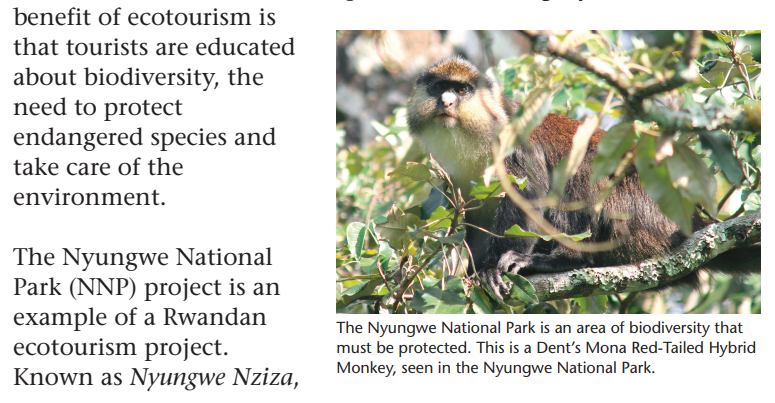
ecotourism destination. This will help to create employment and
provide income for local communities. It will also provide an
economic incentive, in the form of revenue, to conserve the park’srich biodiversity.
The NNP is a rainforest located in South-Western Rwanda. It
borders on Burundi in the South and Lake Kivu and the
Democratic Republic of the Congo to the West. The NNP includes
the largest stretch of remaining mountain in East and Central
Africa. It is home to about 310 different bird species, hundreds of
butterflies and orchids, and over 75 different species of mammals– including 13 primates (about a quarter of all Africa’s primates).
Application Activity 5: Discuss environmental awareness in Rwanda
1. In your groups, find the NNP on a map.
2. See how many other Rwandan national parks you can find and name.
3. Analyse the environmental importance of ecotourism.
4. Discuss what you think would be the long-term outcome if national parks
were not protected and ecotourism was not encouraged.
5. Research and find out how ecotourism helps both the national economyand local communities.
Text: Read the following passage and answer the questions below
Environment and health
Human health is intimately linked to the health of the
environment. Due to rapidly increasing impacts on our planet,
threats to human health are escalating. Among these threats
are an increasing incidence of cancer caused by pollution of air,
land and water, and outbreaks of infectious diseases caused by
habitat disruption. It was widely thought that tropical forests
and intact natural environment teeming with exotic wildlife
threatened
humans by harboring the viruses and pathogens that lead tonew diseases in humans like Ebola, HIV and dengue.
But a number of researchers today think that it is actually
humanity’s destruction of biodiversity that creates the conditions
for new viruses and diseases like COVID-19, the viral disease that
emerged in China in December 2019, to arise—with profoundhealth and economic impacts in rich and poor countries alike.
The environmental sector plays a key role in early warning,
detection, and identifying disease risk, as well as in response.
Human activity degrades our environment every day leading to
water, air and soil pollution. Therefore, improving the quality
of the environment in key areas such as air, water and noise can
prevent diseases and improve human health. Noise exposure from
transport sources and industry can lead to annoyance, sleep
disturbance and related increase in the risk of hypertension andcardiovascular diseases.
Comprehension questions
1. Explain the impact of environment on health.
2. Explain how environment destruction can lead to different diseases and
pandemics.
3. What are the risks of noise exposure from transport sources?
4. List different diseases causes by air pollution and suggest preventionmeasures.
Vocabulary
Construct your own sentences using each of the following
words
a) outbreaks
b) habitat
c) exotic
d) viruses
e) pathogens
f) profound
g) annoyance
h) disturbance
i) hypertensionj) cardiovascular
Application activity:
1. Write a 300-word composition on environmental degradation.
2. Debate on the following topic: Life is better in hot areas than in regionswith cold climate.
Assessment
1. Choose the correct option to complete the following sentences in the
present perfect tense:
a) He ________ passed his exam.
have
has
haven’t
hasn’t
b) He ________ studied for the test.
have has
hasn’t
haven’t (2 marks)
2. Fill in the missing word:
a) Carene has been a professional singer ________ 1989.
b) Joseph has been a pupil here ________ March. (2 marks)
3. Rewrite the following sentences using the passive voice:
a) We set the table.
b) You do not write the letter.
c) Does the police officer catch the thief?
d) He opens the door. (4 marks)
4. Rewrite the following using paragraphs, a main heading
and subheadings: (6 marks)
The land of 1000 hills and home of the mountain gorillas.
We offer the following three tours to Rwanda’s national
parks, where you can see Rwanda’s primates. Mountain
Gorilla Safari – 4 Days. This is our shortest safari and
captures the essence of Rwanda. It includes a visit to the
mountain gorillas in Volcanoes National Park in Northern
Rwanda. Rwanda Primate Explorer – 7 Days. This safari is a
safari where you trek to the various primates found in
Rwanda. You will see the mighty mountain gorilla,
chimpanzees, the golden monkeys and the colobus, and
there is a chance you will see even more species. Rwanda
Discoverer – 7 Days. This safari includes both a visit to the
gorillas and the chimps, as well as a visit to the savannahs
of Akagera National Park in Eastern Rwanda, where a large
variety of animals and birds are found.
5. Write a brief description of the beauty of Rwanda. Make
sure that you describe its physical features. (6 marks)Total (20)
